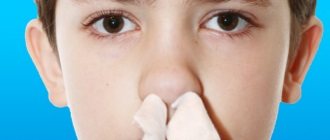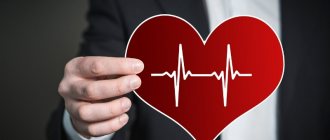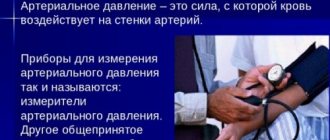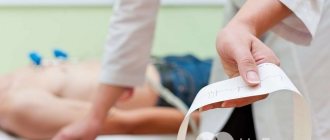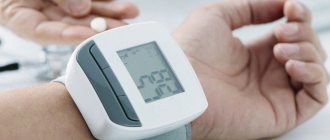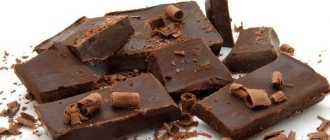Blood pressure is the rate of blood flow through large arteries in the human body, measured in mmHg.
It is divided into two types: diastolic (upper) and systolic (lower). Based on the upper indicator, the pressure of relaxed arteries is determined, and the first criterion depends on the speed of heart contractions. When calculating from systolic blood pressure to distolic blood pressure, pulse pressure is obtained. In adolescents, blood pressure should be about 110*70, in adults under 60 years old 125*85, in elderly people 135*90 mmHg. Art.
Within one day, the human body can experience sudden changes in pressure, which affects its overall well-being. With an increase in the indicator for every 10 mm Hg. the risk of heart and vascular diseases increases.
Signs and consequences of increased blood pressure
Not every person knows his individual blood pressure when he feels normal. But what consequences can occur when blood pressure rises? In medical practice, pathology associated with high blood pressure is called hypertension. This disease manifests itself differently in people of different ages.
Specialists at the Carnelian Medical Center in Novosibirsk noted the main symptoms of high blood pressure:
- regular feeling of coldness in the lower extremities. Swelling associated with cardiac and renal failure may occur;
- excessive heartbeat;
- frequent headaches;
- pain in the cardiac region;
- dizziness when turning or tilting the head;
- stable high blood pressure, which can remain unchanged during emotional changes.
The risk of high blood pressure may appear in elderly patients. The pathology can be inherited or due to head injury. Other risk factors are harmful working conditions and alcohol addiction, lack of sleep, intense physical activity, stress, symptomatic hypertension, thyroid and heart disorders, obesity, smoking, vegetative-vascular dystonia, etc.
Stages of hypertension
For each person, the blood pressure norm is individual. However, the diagnosis of hypertension is most often made when, after measuring blood pressure on two different days, the systolic pressure is equal to or greater than 120 mmHg. Art. and/or the diastolic pressure value is equal to or greater than 80 mmHg. Art.
In this case, high pressure has its own degrees:
- I degree - increase in systolic pressure from 139 to 159 mm Hg. art (diastolic oscillation interval - 90-99 mm Hg);
- II degree - increase in systolic pressure from 160 to 170 mm Hg. Art. (diastolic oscillation interval - 100-109 mm Hg);
- III degree - pressure rises above 180 mm Hg. Art.
There are three stages of hypertension:
- Stage I – mild, blood pressure rises briefly and irregularly, normalizes under favorable conditions; no target organ damage is observed.
- Stage II – moderate, high blood pressure can only be reduced with the help of medications; There is damage to target organs: the heart, kidneys, brain, as well as blood vessels, including the eyes.
- Stage III – severe, target organ damage occurs with thrombosis, heart attacks and strokes.
Signs and consequences of low blood pressure
According to specialists from Carnelian MC, the manifestation of low blood pressure is typical for young women under the age group of 40 years.
Symptoms of disturbances include:
- insufficient blood circulation, leading to throbbing pain in the temporal region of the head;
- sudden change of mood;
- constant apathy, lethargy, feeling tired. The body is not able to recover after a good rest and sleep.
Low blood pressure can manifest itself for various reasons: as a result of previous infections, underweight, anemia, unfavorable work factors, changes in climatic conditions or seasonality. Also, pressure can change as a result of a lack of vitamins, indicating anemia, pre-infarction condition, weight deficiency, cardiosclerosis, VSD, renal failure, low hemoglobin, circulatory disorders, etc.
With a slight change in blood pressure, people live full lives. To avoid health problems, experts recommend exercise, adhere to a healthy lifestyle and proper nutrition, often walk in the fresh air, give up alcohol and take vitamins and fruits. A person should also avoid stress and take care of his health, constantly monitor his blood pressure and keep it normal. Measurements should be taken several times a week; you should not drink alcoholic drinks or coffee, play sports, smoke, or swim in hot water beforehand.
Symptoms of high blood pressure
Many people have high blood pressure without any symptoms for a long time. However, there are several common signs of hypertension: morning headaches, shortness of breath, nosebleeds, irregular heart rhythms, blurred vision, and ringing in the ears.
Uncontrolled high blood pressure can lead to complications such as heart attack or stroke, aneurysm, heart failure, kidney damage, vision loss, metabolic problems, memory problems and dementia.
You can measure your blood pressure yourself, but to make an accurate diagnosis, we advise you to consult a specialist.
What to do if a person has dangerous blood pressure?
Both hypertension and hypotension are considered dangerous and require mandatory treatment. The sooner therapy begins, the better it is for the body. Even the highest blood pressure should not be reduced sharply; this is harmful and dangerous for the body. Combination drugs are used for treatment; they help reduce adverse reactions and increase benefits. Recently, drugs have been manufactured that reduce high blood pressure for a day after one dose. It is equally important to review your diet:
- reduce the amount of salt;
- It is advisable to exclude strong coffee, teas and alcohol;
- completely eliminate animal fats and sugar;
- increase consumption of fresh vegetables and fruits;
- eat foods high in potassium and magnesium.
To increase vascular tone, pills are not always used. Coffee is considered the most accessible means for urgently raising blood pressure levels. All antihypertensive drugs contain caffeine: Citramon, Pyramein, Askofen. Cinnamon water will help to quickly increase even the lowest blood pressure: pour a quarter spoon of cinnamon into one glass of boiling water and drink a maximum of 2 teaspoons to increase levels. For hypotension, combination drugs are also successfully taken, most often a combination of an ACE inhibitor and calcium antagonists, or an ACE inhibitor and a diuretic.
What is worse for a person - high or low blood pressure? The danger lies in any violation of indicators. Therefore, if there are systematic jumps in blood pressure (BP), you should consult a doctor who, after a thorough examination, will prescribe optimal therapeutic and preventive measures.
Critical indicators
Critical norms are considered to be indicators at which the cardiovascular system suffers.
A sharp increase or decrease in tonometer readings is fraught with serious consequences for the cardiovascular system. It is impossible to say an exact figure that will indicate maximum blood pressure for all people. An increase of 20-30 points from the usual, normal level is already dangerous, more than 30 is critical. You can rely on the following numbers:
- below 100/60 mm Hg. st - hypotension;
- above 140/90 mm Hg. Art. - hypertension.
The highest pressure rarely reaches 300 mm Hg. Art., because it guarantees a 100% lethal outcome. During a hypertensive crisis, blood pressure reaches 240-260 per 130-140 mmHg. Critical low blood pressure is 70/40 or even less. High blood pressure threatens the sudden onset of heart failure, sometimes even fatal.
Hypertension
Photo from achieveclinical.com
The diagnosis of “hypertension” (also known as arterial hypertension, arterial hypertension and essential hypertension) is given to a patient if his blood pressure is higher than 140/80.
After making a diagnosis, it is very important to get checked by an endocrinologist, and first of all, determine the levels of glucose and insulin in the blood, since their increase is very often the main cause of high blood pressure.
People with type 2 diabetes are often obese, which is another risk factor for cardiovascular disease, so hypertension and insulin resistance are quite closely related.
A patient suffering from both diseases is prescribed a diet that helps lower blood sugar levels and also lose weight. To do this, you should completely eliminate or significantly reduce the consumption of foods containing sugars and starches, that is, baked goods, pasta, rice, cereals, and potatoes. It is also advisable to limit fruits somewhat, but not completely exclude them, since they are an important source of vitamin C, which is necessary for hypertensive patients.
Old and proven advice to all those suffering from cardiovascular diseases is to regularly eat citrus fruits.
It is important to ensure that the level of fructose consumed is no more than 25 grams per day. For reference : one average orange contains 6 g of fructose, banana - 7, peach - 6, apple - 9.5, pear - 12.
The fact is that one of the breakdown products of fructose is uric acid, the accumulation of which leads to several disorders, including hypertension.
Of course, if you have high blood pressure, you should give up alcohol and smoking - however, these two factors are unnecessary for any ill health.
With hypertension, it is very important to pay attention to whether the pressure decreases at night. If it remains elevated early in the morning, you should definitely check your heart as well as your vitamin D levels. The best way to optimize your body's vitamin D levels is to get regular sun exposure, but if you can't avoid taking extra vitamin D, choose a product that contains the active ingredient. its form is vitamin D3 (not D2).
An excellent source of vitamin D is fish oil. By taking it, you simultaneously replenish your body with omega-3 fatty acids, which, as scientific research shows, also have a cardioprotective effect.
Many experts recommend a salt-free diet for hypertensive patients, especially those whose hypertension is associated with kidney disease (and this is a very common combination of diseases). This issue, however, should be approached carefully and individually.
Photo from deccanchronicle.com
On the one hand, salt actually increases blood pressure, on the other hand, a lack of the main source of sodium can lead to an imbalance in the sodium balance in the body, which often causes a decrease in insulin production and leads to cardiovascular diseases. Therefore, the decision to limit salt should be made taking into account the patient's comorbidities. If such a decision is nevertheless made, hard cheeses, milk, beef, eggs, and rye bread will help replenish sodium in the body.
It's no secret that high blood pressure is often a consequence of stress, especially in middle-aged and elderly people. Advice to avoid troubles would sound strange, because they happen regardless of our will. It is useful, however, to master one or another technique of emotional control. There are many of them, and anyone who sets such a goal will be able to find something that is right for him to maintain peace of mind.
An important part of the prevention and treatment of arterial hypertension is physical exercise. An exercise program for hypertensive patients should include not only aerobic exercise (with a pulse range of 140-160 beats per minute), but also anaerobic exercise (with a pulse range of 160-180 beats per minute), which largely contribute to improving the functioning of the heart and lungs, and reduce risk of cardiovascular diseases.
This includes fast sprints, jumping rope, weight training, climbing steep hills, and any activity that involves heavy loads.
Under no circumstances should you immediately start intense exercise, as this can lead to the exact opposite result. It is best to start with fast walking, jogging, cycling, swimming.
How do coffee and tea affect blood pressure?
Photo from tolowerbloodpressure.com
Contrary to popular belief that coffee increases blood pressure, there is no convincing evidence for this. In 2012, American medical analysts collected and summarized the results of all studies on this subject and came to the conclusion that there is no scientific basis for recommending coffee to increase blood pressure or prohibiting it for those suffering from hypertension.
So if you don’t notice a real deterioration in your well-being after a cup of coffee, drink to your health.
But black tea, as it turned out, affects blood pressure if consumed regularly, and in the direction of reducing it, albeit slightly.
Green tea significantly reduces both systolic and diastolic blood pressure, so it should be avoided by hypotensive people. For hypertensive patients, 1-2 cups of green tea per day significantly reduces the risk of developing heart disease.
How to live with low blood pressure?
Photo from fepblue.org
First of all, a person with hypotension needs to get enough sleep. Some experts advise sleeping up to 10 hours a day, but certainly not less than 8. You need to sleep in a position with your head elevated higher than usual (it is recommended to place something under the legs of the bed to raise its upper edge).
It is also important to follow a diet. Eat small meals more often. Food should be well salted. Reduce carbohydrates in your diet. Try to rest after eating.
Drink plenty of fluids, but avoid alcohol.
Exercise to improve blood circulation, but do not make sudden movements. Do not take a sharply vertical position, do not lift heavy objects.
Keep in mind that the effect of hot water on the body should be short-lived. It is better to take a short shower than to lie in a hot bath for a long time, much less take a steam bath or sauna.
If these measures do not help, your doctor may prescribe a medication, such as midodrine. Supplements such as eleutherococcus or ginseng tincture may also help.
Why is low blood pressure dangerous?
Hypotension is dangerous for the entire body, since all organs do not receive the necessary blood circulation.
Low blood pressure is considered dangerous because due to it, a sufficient amount of oxygen does not enter the main vessels, and the blood supply to organs deteriorates. Poor blood supply to the brain is life-threatening due to the risk of ischemic stroke. Hypotension has a bad effect on a person’s general condition: he feels constant malaise, fatigue, and powerlessness. Heart attack, stroke and heart disease are complications of both hypertension and hypotension. Numerous examples confirm that the transition from hypotension to hypertension is possible. This occurs due to pathological changes in the vessels and their restructuring. This type of hypertension is difficult to tolerate by the body, much worse than others.
Hypotension is a common occurrence early in pregnancy. Dehydration requires drinking a lot, but this is bad for the baby.


